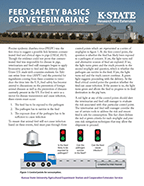Displaying 1 to 15 of 21 Publications
Managing Beef Cows During Cold Stress
by Jason M. Warner Justin Waggoner
MF3684
This publication explores what is cold to a cow?, What nutrients should be increased and by how much?, and how should the feeding program be adjusted? 4 pages, color.
Published Date: Jun 2025
Measuring the Effects of Dry Matter in Beef Cattle
by Jason M. Warner Brandon J. Fraser
MF3676
This publication covers how dry matter is determined on the farm or ranch, how variation in DM influences the composition of a diet, and the implications DM can have on the economics of a nutrition program. Color, 4 pages.
Published Date: Mar 2025
Importance of Dry Matter in Beef Cattle Diets
by Jason M. Warner Brandon J. Fraser
MF3675
This publication outlines what dry matter is, how the terms DM and as-fed (AF) are determined, the appropriate usage of these terms, and examples of the typical DM of feedstuffs. Although this publication is written regarding beef cattle nutrition, the fundamentals discussed apply to feeding scenarios for dairy cattle and small ruminants, in addition to any species in which feedstuff DM content varies. Color, four pages.
Published Date: Mar 2025
Feed Safety Basics for Veterinarians
by Cassandra Jones et al.
MF3548
Describes methods to reduce the risk from swine viruses and other highly contagious livestock diseases. Diseases can be spread by contaminated feed, surfaces such as feed mills, feed equipment, trucks, employee shoes, and similar contact points. Quarantine time, temperature, and anti-microbial feed additives can reduce the risk of pathogens surviving in feed. 4 pages, color.
Published Date: Jun 2021
Salmonella in Livestock Feed
by Cassandra Jones Olivia Harrison
MF3549
Publication describes strategies to decrease the spread of Salmonella disease in feed mills. 4 pages, color.Published Date: Jul 2021
Feed Mill Biosecurity for Feed Mill Managers
by Cassandra Jones et al.
MF3550
Publication describes strategies to reduce the risk of contamination of animal feed by organisms that produce disease such as viruses and bacteria. 4 pages, color.Published Date: Jul 2021
Feeding Low-Test-Weight and Sprouted Wheat
by Twig T. Marston Joel M. DeRouchey
MF2659
Wheat that has been downgraded is priced for feeding rather than milling. Cattle and swine feeders should consider using processed wheat that is unacceptable for milling. 4 p.Published Date: Aug 2004
Diet and Feed Management to Reduce Gaseous Emissions from Livestock Production
by Zifei Liu
MF3386
Gaseous emissions from livestock can be reduced through proper diet and feed management. This publication outlines principles and practices for achieving this goal. 4 pages, b/w.Published Date: Nov 2017
Evaluating Pellet Quality
by Charles Stark Adam Fahrenholz
MF3228
This publication describes techniques used to measure feed pellet quality. 4-page, color.Published Date: Jul 2015
Evaluating Particle Size of Feedstuffs
by Julie Kalivoda Charles Stark
MF3342
This publication describes the equipment and procedure used to evaluate feed particle size. Color, 4-page.Published Date: Nov 2016
Evaluating Feed Components and Finished Feeds
by Timothy J. Herrman Scott Baker
MF2037
Contains information pertaining to ingredient specifications, finished feed properties, types of assays to perform, and interpreting lab results.Revision Date: Oct 2001
Feed Biosecurity for Swine Producers
by Cassandra Jones et al.
MF3547
Questions and answers about feed mill biosecurity practices. 4-page, color.Published Date: Nov 2020
Leachate from Silage and Wet Feed Storage
by Joseph P. Harner III et al.
MF3542
As responsible stewards of the environment, producers need to remain aware of the risk of leachate from silage and other wet feed ingredient storages, and take appropriate steps to reduce and manage the leachate/runoff from feed storage and processing areas. This publication describes factors for consideration and best practices to implement. 4 pages, color.Published Date: Oct 2020
Composition and Feeding Value of Cottonseed Feed Products for Beef Cattle
by Dale A. Blasi Jim Drouillard
MF2538
Nutrient composition and feeding management of whole cottonseed, cottonseed meal and hulls. This will help beef producers use cottonseed by-products, reducing costs of production. 22 p.Published Date: May 2002
Wheat Middlings Composition, Feeding Value, and Storage Guidelines
by Dale A. Blasi Gerry Kuhl Keith C. Behnke
MF2353
Optimal storage conditions and feed value of wheat middlings for livestock consumption.Published Date: Aug 1998
Displaying 1 to 15 of 21 Publications
 Sign in
Sign in















